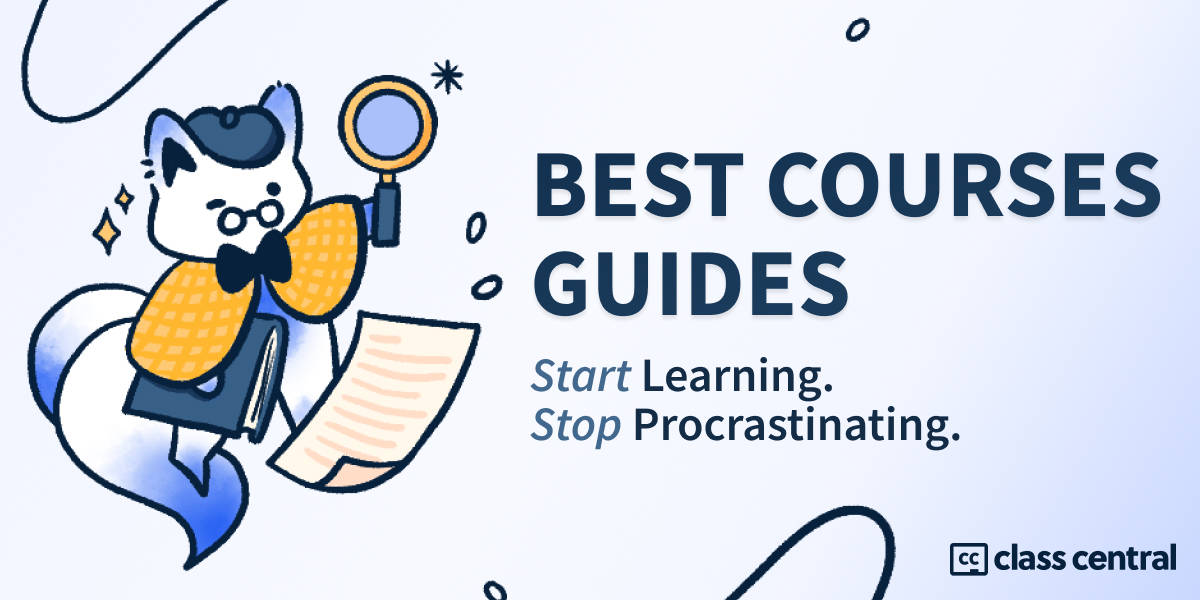9 Best Relativity Courses for 2025: Special and General Relativity
Learn relativity with online courses by top physicists from Stanford, MIT, and more! Or if you prefer learning from a book, see our recommendations.

Quick Access:
- Special and General Relativity Courses: Wang (Hong Kong University), Susskind (Stanford)
- Special Relativity Courses: Lagerstrom (Stanford), Klute (MIT), Greene (Columbia)
- General Relativity Course: Hughes (MIT)
- Relativity Books: Carroll, Wald, Landau and Lifshitz (free)
You’ve heard about Einstein and relativity, right? But do you wonder just what relativity is? And whether you can learn it without going to a university?
The good news is, with online courses, communities, and books, it is possible to teach yourself relativity. The (possibly) bad news is, unless you have a strong grounding in mathematics and classical physics you may find it a challenge. But there are plenty of online mathematics and physics courses to help! Look out for future Best Courses Guides (BCGs) for these subjects.
I have arranged the resources in this BCG with special relativity first, since you need to understand special relativity before going on to general relativity. Einstein published his theory of special relativity in 1905 (including the famous equation E=mc^2), followed by the theory of general relativity in 1915.
Click on the shortcuts for more details:
- Top Picks
- Relativity Communities
- What is Relativity?
- Uses of Relativity
- Resources Overview
- Why You Should Trust Us
- How We Made Our Picks and Tested Them
Here are our top picks
Click to skip to the course details:
Learning Guides
Relativity Communities
Taking online courses and reading books can be a great low-cost way to learn relativity, and online communities can help if you’re feeling lonely or get stuck:
- Connect with over 700 members of the special (SR) and/or general (GR) physics theories of relativity with the Reddit relativity community
- Ask and answer questions on the Stack Exchange special relativity and general relativity sites
- Quora also has a relativity topic with 1.5 million followers, or see their special relativity and general relativity topics.
What is Relativity?
Albert Einstein published two groundbreaking theories that revolutionized our understanding of space, time, energy, and gravity.
Special relativity, introduced in 1905, deals with the relativity of motion in inertial (non-accelerating) frames of reference. Its key principles and conclusions include:
- The laws of physics are the same in all inertial frames of reference
- The speed of light in a vacuum is constant and independent of the motion of the source or observer
- Nothing can travel faster than the speed of light
- Time dilation – moving clocks run slower compared to stationary ones
- Length contraction – moving objects appear shortened in the direction of motion
- Mass and energy are equivalent and related by the famous equation E=mc^2.
General relativity, introduced ten years later, is a theory of gravitation that describes gravity not as a force, but as a consequence of the curvature of spacetime caused by the presence of mass and energy. Its key principles include:
- The equivalence principle – gravitational and inertial forces are equivalent
- Gravity arises from the warping or curvature of spacetime by mass/energy
- Massive objects distort the geometry of spacetime, causing other objects to follow curved trajectories
- It accounts for phenomena like gravitational redshift, bending of light by gravity, and black holes
- It provides the framework for understanding cosmological phenomena like the Big Bang.
These theories led to profound insights into the nature of the universe that were unable to be explained by classical physics.
Uses of Relativity
Our understanding and application of relativity has led to many major technological advances of the 20th and 21st centuries:
- Global Positioning System (GPS): the accuracy of GPS relies heavily on accounting for relativistic effects predicted by Einstein’s theories. The satellites experience time dilation due to their high speeds (special relativity), and their clocks are also affected by gravitational redshift from being farther away from Earth’s mass (general relativity). Without correcting for these relativistic factors, the GPS would be wildly inaccurate
- Particle accelerators and particle physics: the famous equation E=mc^2 from special relativity relates the mass and energy of particles, which is essential for studying subatomic particles and their interactions. Particle accelerators that boost particles to near light-speeds could not be properly designed without incorporating relativistic principles
- Cosmology and Understanding the Universe: general relativity provides the framework for understanding the expansion of the universe, the existence of black holes, gravitational lensing, and even the origin of the universe in the Big Bang theory. Observations of gravitational redshift and bending of light by massive objects have confirmed predictions of general relativity
- Nuclear Energy and Weapons: the mass-energy equivalence from E=mc^2 determines the energy released when particles are created, annihilated or converted, which underpins nuclear fission and fusion processes used in nuclear power and weapons
- Lasers and Optics: Einstein’s insights into the nature of light and his work on the photoelectric effect laid the foundation for the development of lasers and modern optics technologies including laser pointers, barcode scanners, and fiber optics
- Astronomical Observations: the gravitational redshift predicted by general relativity has been observed in light from distant stars and galaxies, providing evidence for the theory and enabling new astronomical measurements and discoveries.
Resources Overview
- 7 resources are free or free to audit and 2 are paid
- 2 courses offer a certificate of completion
- Courses in this guide have more than 2 million enrollments and views
- The most featured provider is YouTube with 3 courses, followed by Coursera and MIT OpenCourseWare with 2 courses each.
Best Special and General Relativity Course (The Hong Kong University of Science and Technology)
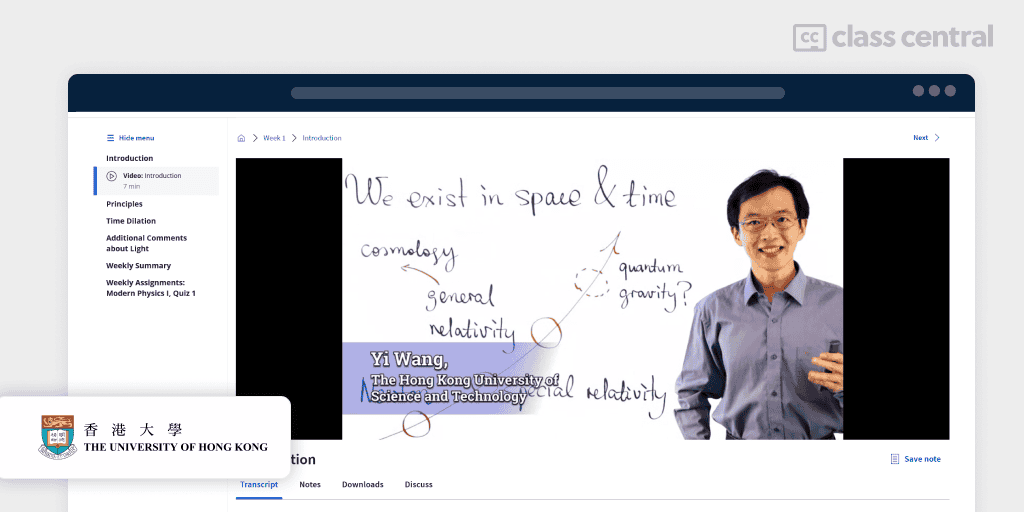
Understanding Modern Physics I: Relativity and Cosmology delves into the fundamental concepts of modern physics developed over the past century, focusing on special relativity, general relativity, and cosmology. It explores how perceptions of space and time are relative and interconnected in spacetime, the implications of spacetime curvature on gravity, and the broader framework of the universe’s evolution, addressing questions about the origin and fate of the universe.
Syllabus:
- Special Relativity: relativity of space and time, length, simultaneity, and Lorentz transformation, geometry, energy, and momentum
- General Relativity and cosmology
“Instructor did an excellent job of introducing new topics by asking rhetorical questions that highlight what is to be covered next…” – J.W., Coursera learner.
| Provider | Coursera |
| University | The Hong Kong University of Science and Technology |
| Instructor | Yi Wang |
| Time Commitment | 12 hours |
| Enrollment | 13.9K |
| Rating | 4.7/5.0 (118) |
| Cost | Free audit |
| Quizzes/Problems | Quizzes: Free |
| Certificate | Paid |
Also Great Special and General Relativity Courses (Stanford University)
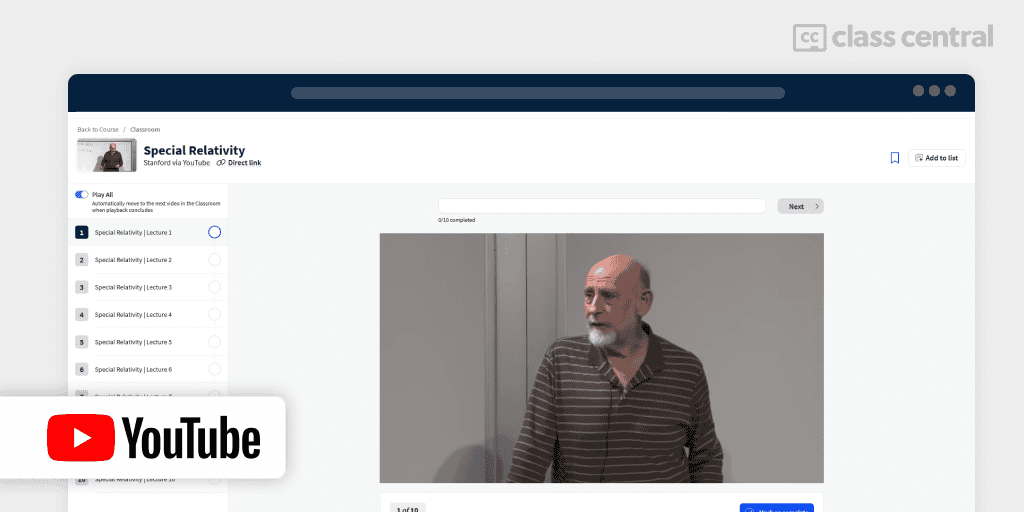
Leonard Susskind said, “A number of years ago I became aware of the large number of physics enthusiasts out there who have no venue to learn modern physics and cosmology. Fat advanced textbooks are not suitable to people who have no teacher to ask questions of, and the popular literature does not go deeply enough to satisfy these curious people. So I started a series of courses on modern physics at Stanford University where I am a professor of physics. The courses are specifically aimed at people who know, or once knew, a bit of algebra and calculus, but are more or less beginners.”
You, too, can access Susskind’s lectures on Special Relativity and General relativity for free.
You will learn:
- Special relativity and classical field theory concepts: space-time and four-dimensional space-time, electromagnetic fields and their application to Maxwell’s equations, the work of the German mathematician Hermann Minkowski
- General relativity: basic ideas of Riemannian and curved space, and Minkowski’s “space-time,” Einstein’s discovery of how gravity is really the curvature of space-time, black holes and their strangely paradoxical properties
- The final lectures develop the essential ideas of Big Bang cosmology.
If you like to learn with books or use them to supplement the videos, Professor Susskind has written a series titled The Theoretical Minimum with various co-authors. Titles include Classical Mechanics, Quantum Mechanics, Special Relativity and Classical Field Theory, and General Relativity.
“This first lecture really blew my mind the first time i saw. This isn’t gold; it’s platinum! Susskind continues to inspire my own teaching, and of course, my study of physics :)” – @superserkit, YouTube learner.
| Provider | YouTube |
| Institution | Stanford University |
| Instructor | Leonard Susskind |
| Time Commitment | 35 hours |
| Views | 735K |
| Cost | Free |
| Quizzes/Problems | Not available |
| Certificate | None |
Best Comprehensive Course on Special Relativity (Stanford)
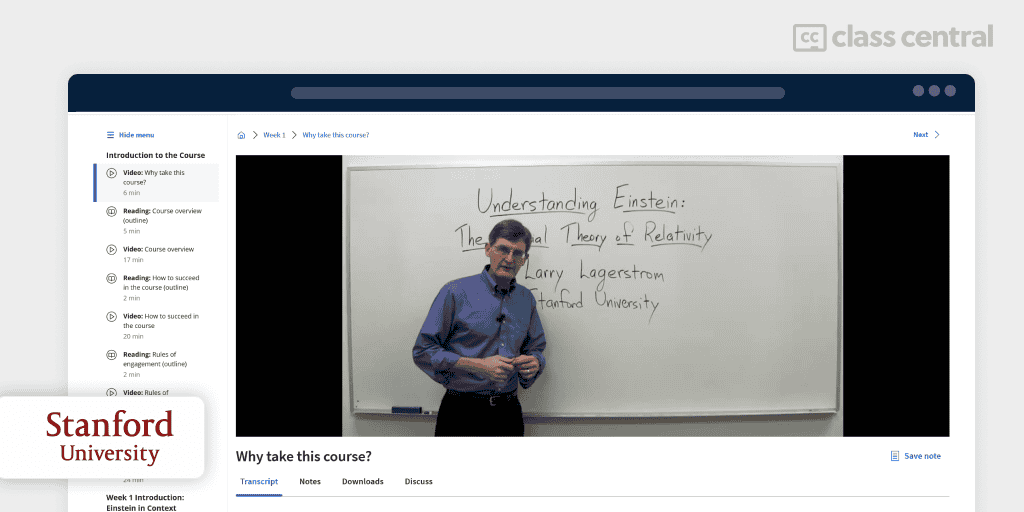
Understanding Einstein: The Special Theory of Relativity delves into Albert Einstein’s development of the special theory of relativity in 1905. It explores Einstein’s ideas, the nature of his genius, and the fundamental aspects of the theory including time as the fourth dimension, time dilation, space contraction, and the impossibility of surpassing the speed of light. The course aims to provide a deeper understanding of both Einstein as a person and the profound implications of his theory.
This course covers:
- Introduction to the course, and Einstein in context
- Foundational concepts: events, clocks, and reference frames
- Early challenges and solutions: ethereal problems and solutions
- Emerging complexities: the weirdness begins, spacetime switches
- Implications and limitations: breaking the spacetime speed limit
- Advanced topics and paradoxes: paradoxes to ponder
- Practical applications and hypothetical scenarios
- To the center of the galaxy and back.
“Professor Lagerstrom has that rare combination of precise knowledge of a subject matter and the ability to convey this knowledge to his students. Because of his teaching methods, I am now able to understand a topic that I could only wonder about before…” – Russell L. McCoy, Class Central learner.
| Provider | Coursera |
| Institution | Stanford University |
| Instructor | Larry Randles Lagerstrom |
| Time Commitment | 81 hours |
| Enrollment | 165K |
| Rating | 4.9/5.0 (2.9K) |
| Cost | Free audit |
| Quizzes/Problems | Quizzes: Free |
| Certificate | Paid |
Best Short Special Relativity Course (MIT)
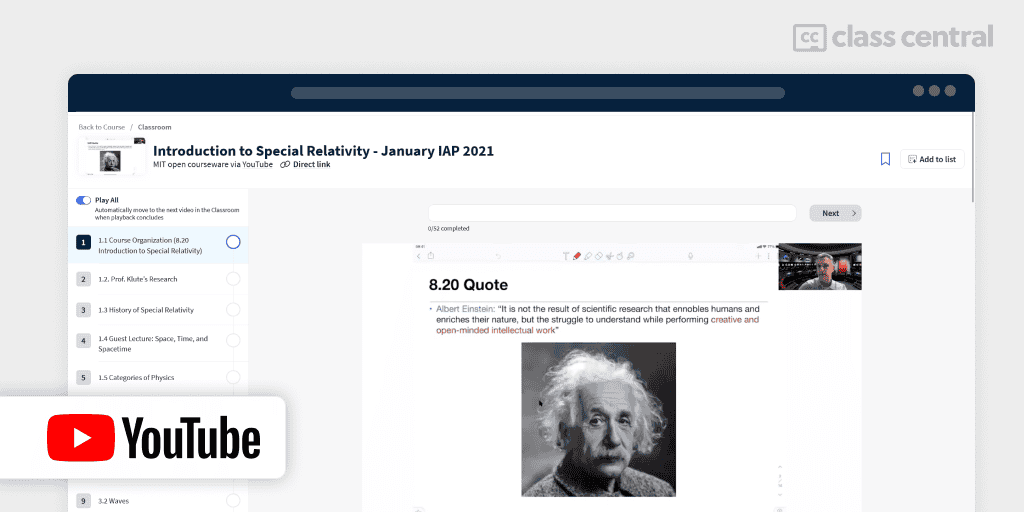
According to Markus Klute, the course instructor, if this is your first introduction to relativity, “It will blow your mind.”
Albert Einstein’s theory of special relativity is explored comprehensively in Introduction to Special Relativity – January IAP 2021. The course also delves into the historical development of the theory, its experimental tests, and its implications for modern physics.
Syllabus overview:
- Introduction: Prof. Klute’s research, history of special relativity
- Guest lecture: space, time, and spacetime
- Basic concepts and transformations
- Experimental foundations
- Relativistic effects
- Paradoxes and thought experiments
- Doppler effect and redshift
- Conservation laws and relativistic dynamics
- Applications and tests of relativity
- Electromagnetism in relativity
- General relativity and further implications.
Find the assignments and exams (and solutions) on MIT OpenCourseWare (MIT OCW).
“Learned a lot of new things. The course was very much well designed as well as well represented…” – Avik Das, Class Central learner.
| Provider | YouTube/MIT OCW |
| University | Massachusetts Institute of Technology |
| Instructor | Markus Klute |
| Time Commitment | 7 hours |
| Enrollment | 217K views |
| Rating | 5.0/5.0 |
| Cost | Free |
| Quizzes/Problems | Free |
| Certificate | None |
Also Great Course About Special Relativity (Brian Greene)
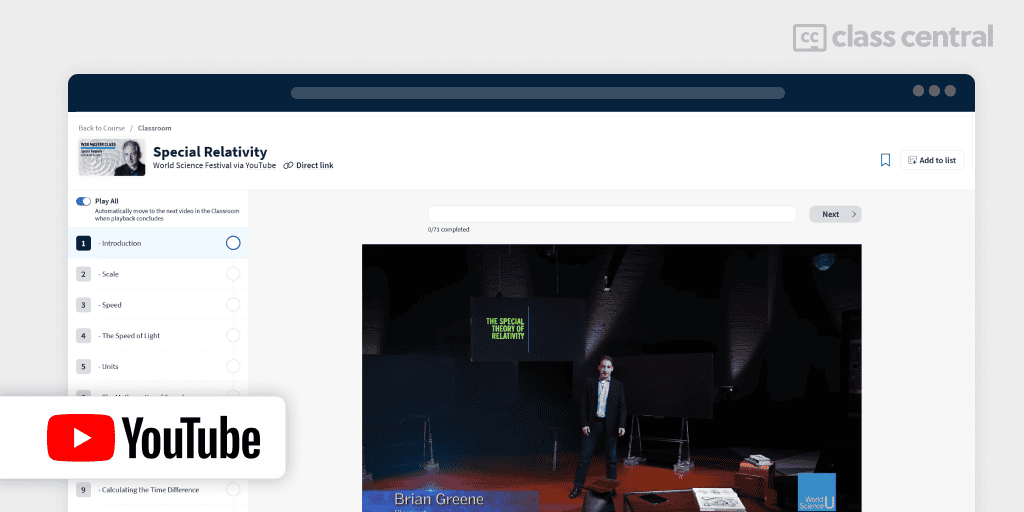
Brian Greene has created a course and book on Special Relativity that offer a math-based introduction to Einstein’s theory that revolutionized concepts of space, time, and energy. Accessible with just high school algebra, the course explores the intricate details of how motion affects time and space, demonstrating these concepts through mathematical formulas and real-world examples.
Syllabus:
- Introduction to special relativity
- Concepts of time in special relativity
- Spatial effects of motion
- Transformations and paradoxes
- Relativistic effects and implications
- Course conclusion
Find the exercises, problems and final exam via World Science U.
You may also want to watch Greene’s brief lecture on Einstein’s General Theory of Relativity – The Essential Idea.
“Why is Mr Green not winning some kind of award for this? This is some of the best work Ive ever seen. All for free…” – @davidfredericks9753, YouTube learner.
| Provider | YouTube/World Science U |
| Institution | Columbia University |
| Instructor | Brian Greene |
| Time Commitment | 11-12 hours |
| Views | 1M |
| Likes | 21K |
| Cost | Free |
| Quizzes/Problems | Free |
| Certificate | None |
Best General Relativity Course (MIT)
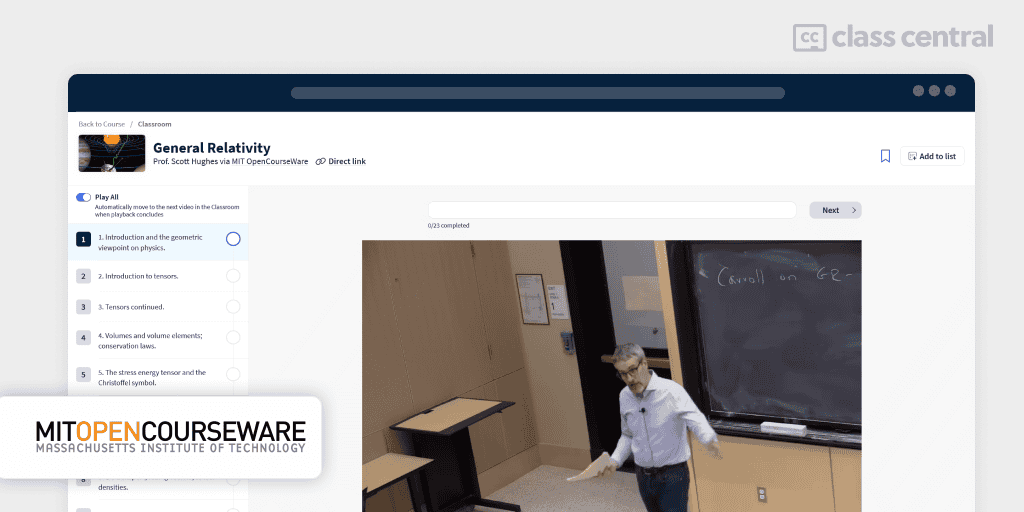
General Relativity delves into the fundamental principles and mathematical frameworks of general relativity. It covers a broad range of topics, providing a comprehensive understanding of the theory’s applications in physics. This course uses the textbook written by Sean Carroll (below).
In this course, you will learn:
- Introduction and basics
- Mathematical tools and principles
- Geodesics and curvature
- Einstein’s field equations
- Linearized gravity and gravitational radiation
- Cosmology
- Compact sources and black holes
“This course is very helpful for physics lovers and also helpful for those who want to research in future……great work” – Anonymous Class Central learner.
| Provider | MIT OCW |
| University | Massachusetts Institute of Technology |
| Instructor | Prof. Scott Hughes |
| Time Commitment | 30 hours |
| Cost | Free |
| Quizzes/Problems | Free |
| Certificate | None |
Best Book on Relativity (Sean M. Carroll)
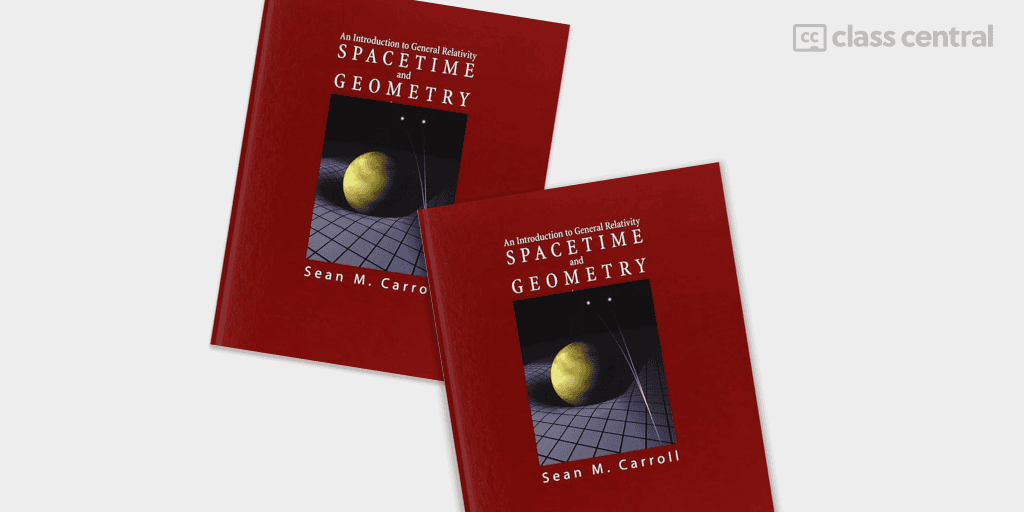
Spacetime and Geometry An Introduction to General Relativity is an introductory textbook on general relativity for students. It prepares students for research-level problems in gravitational physics and includes a brief introduction to quantum field theory in curved spacetime.
It’s a lucid, approachable introduction to an often intimidating subject.
Contents include:
- Theory and mathematical formalism of general relativity
- Black holes
- Perturbation theory and gravitational waves
- Cosmology
- Origin of spacetime curvature (Einstein equation)
- Movement of matter through spacetime (geodesic equation)
- Nature of black holes
- Generation and detection of gravitational waves
- Modern view of the universe’s expansion.
“Carroll brings a relaxed authority to the teaching of general relativity at the graduate level. The text is beautifully written and succeeds in linking modern mathematical formalism to physical applications.” – Roger Blandford – Stanford University, California.
| Publisher | Cambridge University Press |
| Author | Sean M. Carroll |
| Workload | 516 pages |
| Year Published | 2019 |
| Rating (Amazon/Goodreads) | 4.8 (422)/4.3 (494) |
| Cost | Paid |
| Problems/Exercises | Yes, but solutions are not included |
| Certificate | None |
More Advanced General Relativity Book (Robert M. Wald)
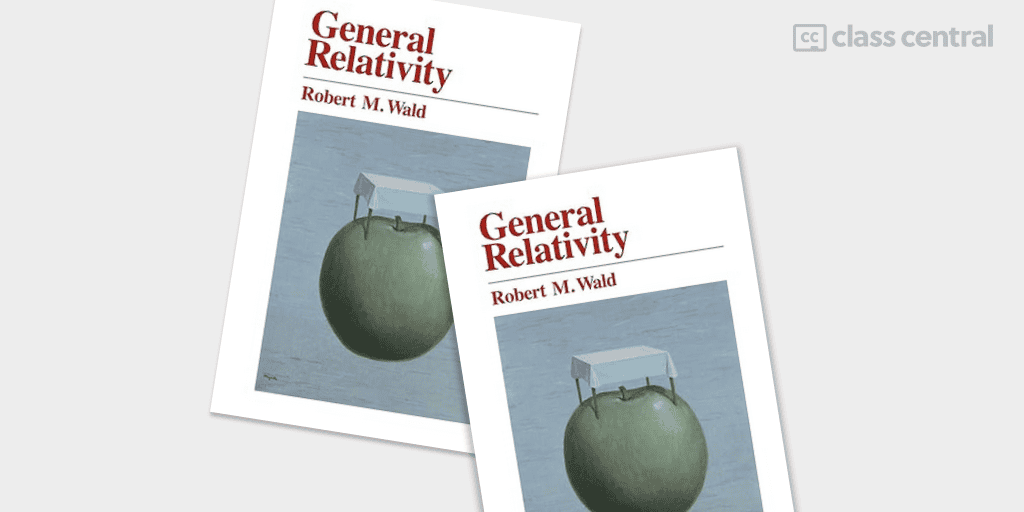
Wald’s book, General Relativity, is a graduate level text that requires prior knowledge of mathematics and classical physics. Some sources recommend taking a course or two and working through Carroll’s book (above) before tackling this text.
Fundamentals:
- Introduction: space and time in prerelativity and special relativity, spacetime metric, general relativity
- Manifolds and tensor fields: manifolds, vectors, tensors, metric tensor, abstract index notation
- Curvature: derivative operators, parallel transport, curvature, geodesics, computing curvature
- Einstein’s equation: geometry of space, special and general relativity, linearized gravity
- Homogeneous, isotropic cosmology: homogeneity, isotropy, cosmological dynamics, redshift, horizons, universe evolution
- The Schwarzschild solution: derivation, interior solutions, geodesics, Kruskal extension.
Advanced topics:
- Methods for solving Einstein’s equation: stationary solutions, homogeneous cosmologies, special solutions, perturbations
- Causal Structure: futures, pasts, causality, domains of dependence
- Singularities: definitions, geodesic congruences, conjugate points, singularity theorems
- Initial value formulation: for particles, fields, and general relativity
- Asymptotic flatness: conformal infinity, energy
- Black Holes: properties, charged Kerr Black Holes, energy extraction, thermodynamics
- Spinors: in Minkowski and curved spacetime
- Quantum effects in strong gravitational fields: quantum gravity, fields in curved spacetime, particle creation, Black Hole thermodynamics.
“If you’re looking for a book to take you through the derivations and implications of GR, this is the book for you. That said make sure your understanding of manifold theory, geometry, and tensor mathematics are up to snuff. This is not a book for beginners.” – Kesedrith, Amazon customer.
| Publisher | University of Chicago Press |
| Author | Robert M. Wald |
| Workload | 506 pages |
| Year Published | 1984 |
| Rating (Amazon/Goodreads) | 4.5 (211)/4.3 (300) |
| Cost | Paid |
| Problems/Exercises | Yes, but solutions are not included |
| Certificate | None |
Best Free Relativity Textbook (Landau and Lifshitz)
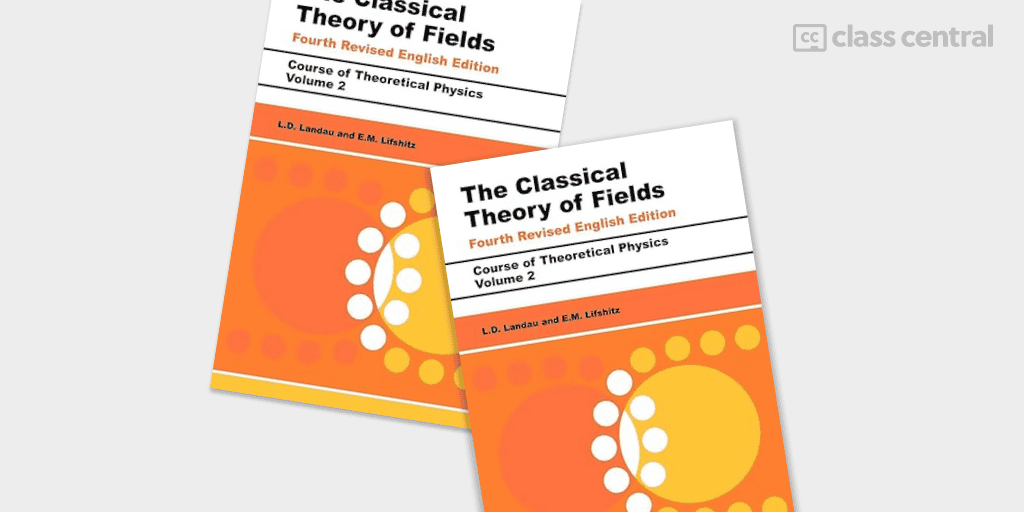
Volume 2 of Landau And Lifshitz’s Course of Theoretical Physics series is titled The Classical Theory of Fields. This book covers the theory of the electromagnetic and gravitational fields: electrodynamics and general relativity. The whole series is available online for free!
Chapters include:
- The principle of relativity
- Relativistic mechanics
- Charges in Electromagnetic fields
- The electromagnetic field equations
- Constant electromagnetic fields
- Electromagnetic waves
- The propagation of light
- Radiation of electromagnetic waves
- Particle in a gravitational field
- The gravitational field equations
- The field of gravitating bodies
- Gravitational waves
- Relativistic cosmology
“…I believe, contrary to many, that this book is appropriate for self study if one is willing to do the work (not only the exercises but following along pencil in hand). I suggest reading a passage and then covering it up and then trying to do the derivations by hand…” – Least Action Hero, Amazon customer.
| Publisher | Butterworth-Heinemann |
| Authors | L.D.Landau and E.M. Lifshitz |
| Workload | 444 pages |
| Rating (Amazon/Goodreads) | 4.4 (107)/4.58 (240) |
| Cost | Free online |
| Problems/Exercises | Yes, but solutions are not included |
| Certificate | None |
Why You Should Trust Us
Class Central, a Tripadvisor for online education, has helped 60 million learners find their next course. We’ve been combing through online education for more than a decade to aggregate a catalog of 200,000 online courses and 200,000 reviews written by our users. And we’re online learners ourselves: combined, the Class Central team has completed over 400 online courses, including online degrees. I’ve personally completed over 200 online courses in a variety of topics.
How We Made Our Picks and Tested Them
Trying to find “the best” can be daunting, even for those of us who live and breathe online courses. Here’s how I approached this task.
First, I combed through Class Central’s Catalog and the internet to find a variety of free and paid open courses and books. You don’t need to enroll in a university to learn about relativity.
When choosing courses, I considered the following factors:
- Renowned Institutions: I looked for recognized institutions in relativity
- Instructor experience: I sought instructors with engaging presentation styles and extensive experience in relativity
- Popularity: I checked numbers of enrollments and views to find popular courses
- Content: I examined courses and books that covered a range of topics and presentation styles, including the basics and more advanced topics. I watched some course videos to sample courses I hadn’t already taken
- Learner reviews: I read learner reviews (when available) to get a sense of the quality of each course, leveraging the Class Central database with its thousands of course ratings and reviews written by our users as well as available external reviews.
Then, I defined the scope for these recommendations and chose top courses and books covering both special and general relativity.
Ultimately, I used a combination of data and my own judgment to make these picks. I’m confident these recommendations will be a reliable way to learn about relativity.


